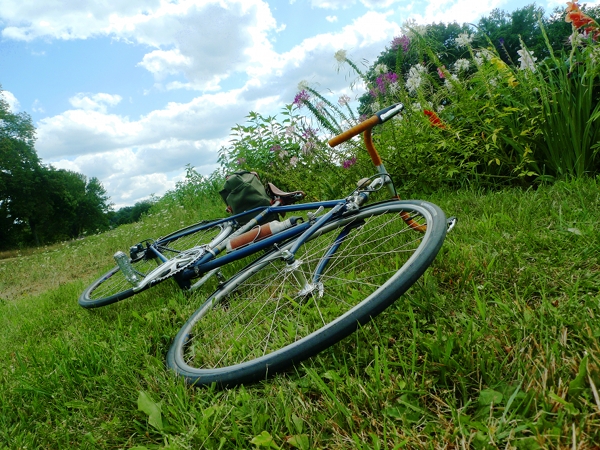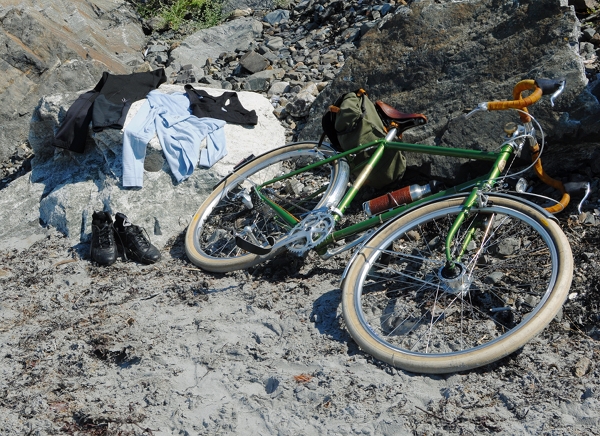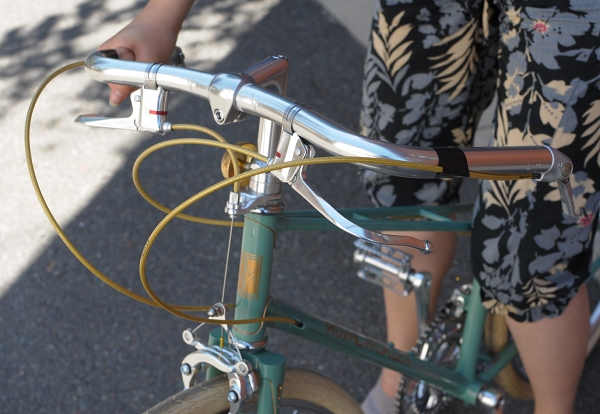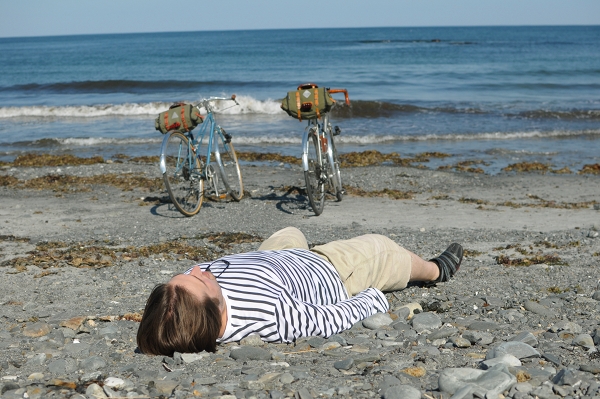Happy Trails! Tips for Long Rides
Though not all will agree with this, I believe that in order to honestly say that you are able to cycle a given distance, it has to mean that you are able to do it successfully. In other words, if you managed to complete a long ride, but could not walk the next day as a result, that does not count as "success"!
I consider my first half-century (50 mile) ride to have happened this summer - despite having once cycled that distance in Austria some time ago. That earlier trip was a disaster, and I wish somebody had warned me against it. Emboldened by having gone on a handful of short rides, one day I just kept going and going - and didn't stop despite feeling discomfort and pain. Riding a rental bike with a plush vinyl saddle and sub-optimal geometry, I pushed myself well past my limits, ignoring my body's warning signs. And after the ride was over, I could not cycle for over two weeks.
That incident served as a painful lesson: Being able to handle long rides was not about exceeding my abilities. It was about staying within my abilities - while working to gradually expand them. When I finally did my first "real" 50 mile ride this summer, I was ready for it and it felt fantastic. Only then did I feel that I could truly say "Now I can cycle a half century".
Having received emails asking for advice on taking long rides, I offer some tips based on personal experience. Think of these as food for thought!
1. Build up to it. Even if you think you can do it, don't start with a long ride. Start with short rides and gradually increase the distance. Ideally, a ride should still leave you able to cycle the next day.
1. Build up to it. Even if you think you can do it, don't start with a long ride. Start with short rides and gradually increase the distance. Ideally, a ride should still leave you able to cycle the next day.
2. Make sure your bicycle is comfortable. The only way to do this is to get to know your bicycle, which, once again, can only happen over time and over gradually increased distances. The way a bicycle feels on short rides is not an indicator of how it will feel on a long ride. It also takes time to break in a saddle and to "dial in" your optimal sitting position on a new bicycle.
3. Make informed and practical clothing choices. The very same pants that feel great on a 10 mile ride, can make your crotch bleed by mile 50 - as the seams begin to chafe against the delicate skin in that part of the body. By increasing distance gradually, you will be able to spot problematic tendencies before they turn into actual problems and cause damage.
4. Consider terrain. A hilly ride is far more difficult than the same distance covered on flat terrain. You may be perfectly capable of completing a 50 mile ride in Kansas, yet find it impossible in Vermont.
5. Shift gears. The longer and hillier the ride, the more you should be switching gears. Make it a point to switch to a lower gear when going uphill, even if it feels like you do not "need" to. Otherwise, you will waste your energy on tackling hills and will not have enough left to endure the ride. As a rule of thumb, it is good to aim for pedaling at the same rate throughout your ride. If you find your legs moving slower, because it is difficult to turn the pedals, that is a sign that you need to switch to a lower gear.
6. Expect to make adjustments to your bike, and possibly replacements. If something does not work for you, admit it and do something about it. This may include replacing components such as your saddle, handlebars, grips, gear shifters, etc. - or even your bicycle itself. Sometimes we read great reviews of things, and yet these things turn out not to be right for us. Get something that works for you.
7. Eat and drink. Cycling can suppress your appetite and trick you into thinking that you are not hungry... until you crash and find yourself completely unable to continue. This weird phenomenon can really sneak up on you. If you are going on a long ride, make it a point to snack when you take water breaks. Some people like energy bars and energy drinks, while others believe them to be unhealthy. I prefer trail mix or chocolate to energy bars. And adding some lemon juice and (a pinch of) salt to your water bottle makes for an effective, all-natural electrolyte replacement drink.
8. Most importantly, listen to your body and go at your own pace. Have realistic expectations and be patient. So you envisioned yourself crossing the Alps this summer, yet you can't manage more than 20 miles on your local rail-trail? So what! Enjoy those 20 miles and keep doing them over and over. One day you will surprise yourself.
Autumn is the best season of the year for cycling. Happy trails!









Hi Velouria, thanks for the tips, I've been cycling for 5-6 years now, commuting mainly, and have never yet done a half century. Time, and committments are the main problems, but I intend to do one soon. I cycle 40 mile roundtrips back and forth work, but there's a big gap between each section of 20 miles, I've done 30 plus mile loops locally, do you think the jump to 50, would be too much.
ReplyDeleteI agree completely, the first time I did anything over 30 miles I felt pretty sore the next day. I had to go to the dentist a few times earlier this year (17 miles each way) and after I had done that about 4 times in a few weeks I ended up going on critical mass when I returned. I'm not sure that everyone would count it as valid though, I swapped from DL-1 at mile 40 to Yuba Mundo for the remaining 10.
ReplyDeleteGreat advice from someone who knows what's what. I get tired of reading this sort of thing in magazines and sunday paper "Lifestyles" sections that when you actually read them are full of the same stupid misinformation masquerading as common sense.
ReplyDeleteI recently read a guide to cycling the rail-trails of rural Iowa, it contained bits of information like "make sure your bike has enough gears for hilly terrain so you can avoid pedalling too fast for safety" and then in the same paragraph encourages riders to "consider a non-speed coaster brake bike to avoid shifting confusion". They also warned against having the seat so high that ones feet can't reach the ground when "maneuvering" and advised "raising the seat a little while pedalling for taller riders".
Admittedly this guide was probably 15 years old and good cycling advice is a lot more common now, but, who the heck wrote that?
If I stop now I think I can avoid an all-out freakout...so, I better go. I hope you're having fun.
Spindizzy
welshcyclist - If you commute 40 miles/day, I'd say definitely. Just pace yourself and go slower than you would on the 20 mile stretches. Time is indeed a problem. It takes me 4 hours to ride 50 miles, including short breaks, so this is only something that can be done on a day off.
ReplyDeleteI so needed this advice! It is perfect for someone who wants to get into riding longer distances.
ReplyDeleteI have been cycling for well over three decades, so you'd think I'd know better. But after my surgery-induced layoff from cycling last year, I was champing at the bit when I got back on my bike. The result was that I tried to ride too much too early and ended up with a tear that resulted in an infection in a sensitive area. That kept me off my bike again for more than a month in the spring.
ReplyDeleteMy rule of thumb is that if I've been riding consistently and without pain, I know I can do something about ten kilometers longer than my previous longest ride of the season. Then, after I've done about three or four rides of that length within six weeks to two months, I know I can take a longer ride.
Now, some of you may look at my photos and question my conditioning. Admittedly, I'm not in the shape I once was. But I know that if I continue cycling, and yield not to a temptation or two, I can drop some weight--and ride even more!
Weekly mileage is a good guide to what you can do at a special event. I rarely ride more than 25 miles at a time but have no problems doing a century because I ride 200 miles a week and am acclimated. The only mod for the longer distance is to take some extra care in clothing choice and hydration.
ReplyDeleteV.
ReplyDeleteYour advice to add salt to the water bottle, without specifying the quantity, is dangerous. In those who are unfit and pushing themselves beyond reasonable limits. muscle breakdown stresses the kidney.Salt exaggerates that stress. I think it would be better to add a teaspoon of cane syrup to the bottle. Most of the food (trail mix, etc.) that we carry contains more than enough salt.
You should have an occasional stop, and get off the bike to stretch or take a comfort break - but not for too long! No more than 5-10 minutes, or the muscles will start to cool off and stiffen up. That makes it so much worse when you start up again.
ReplyDeleteMax
Anne - I have changed the wording to a "pinch of salt". Most energy drinks contain quite a bit of salt, more than the drink I suggest. The reason I suggest salt is that it helps water absorb when a person is dehydrated. Drinking water alone is not always sufficient.
ReplyDeleteVelouria,
ReplyDeleteYour always-good blog is at its best when it showcases your impressive abilities as a teacher. Your ability to share your experiences and translate them into helpful information for others keeps me coming back even when I'm in a bit of a bike snit, such as now.
If you ever tire of the art/fashion/design/photography/blog world, you could be a teacher. Patient, accessible instruction is rare, but you've got a gift for it.
Great tips. Could I also please add, make sure you have a puncture repair kit. 2 miles from the train station is a pleasant walk, 30 miles from the nearest town . . . not so good! :)
ReplyDeleteJustine - Your "10 km longer" rule of thumb works for me as well.
ReplyDeleteMike - I am a university professor in my dayjob : )
BB - I have what is probably a controversial view on puncture repair: I think that advising beginner cyclists that this is a "must" can intimidate those who are not mechanically inclined from cycling long distance. Not everybody can repair punctures or even remove a wheel from their bike, even after trying to learn. And not everybody has time or wishes to learn. I would much rather advocate investing in some tires with strong kevlar protection, and then flats will be highly improbable.
ReplyDeleteSports drinks indeed contain a lot of sodium among other "stuff." I think Velouria's suggestion aims to replicate these at home without the sweet artificial gatory goodness.
ReplyDeleteEveryone loses a bit of salt when they sweat, but some people lose too much. I have a riding buddy who has that "problem." He would get headaches after long rides, sometimes exhibiting classic hung over symptoms, again, possibly from dehydration. And he literally carried a gallon jug of water in his back pack on our last ride together. He's not alone, lots of long distance runners and cyclists carry and use salt tablets because the salt per volume in Gatoraid-type drinks is not enough for them.
The body needs a very strict balance of electrolytes, including sodium. When extremely dehydrated, extra water just dilutes the available sodium and makes the dehydration problem worse. Properly salted drinks have been argued to help. Of course it's a contested subject, (as anything else diet-related) and some people feel very strongly about "sodium" and "salt" in any dietary setting. Anne @ 1.14m points out a very real danger of kidney failure. I think she is talking about rhabdomyolysis and I feel it's definitely outside the scope of this discussion to determine what lever of muscle damage is acceptable risk to everyone. This isn't medical advice. There's Google for that. :) Let's just state that riding long distances is inherently dangerous. So is marathon running.
In any case, if anyone feels headachy after long rides yet drinks like a horse and their cycling clothing is always caked with salt, maybe they should try it just once to see if it helps. Salted water tastes gross, though, which is where lemon comes in. I am not sure what I would do if I had this problem, probably eat lots of salted chips along the ride. They don't weigh anything.
Sorry about the long comment!
MDI -Yes, that is what I meant.
ReplyDeleteI know that I lose some salt after strenuous rides, because my clothing is often salt-enctusted afterwards and I tend to crave salty/savory foods. What I do is drink vegetable juice when I get home, like V8. I actually do not myself add salt to my water while cycling, I drink it plain. But the advice is for those who would otherwise drink Gatorade or other commercial energy drinks.
Probably a valid point for 'beginner' cyclists as long as they are travelling a reasonably populated route, with mobile phone coverage. Which I guess would be good advice anyway if someone is just starting out. I totally agree about the tyre choice. Nobody wants to spend their time fixing flats if they can help it. (Marathon Plus, my hero!)
ReplyDeleteFirst off, healthy adults doing moderate exercise with a decent diet and fluid intake do not generally need any special fluids. But under certain conditions--hot days, suboptimal intake, overexertion, dehydration is a distinct risk. In that case, it would be best to have "oral rehydration salts" on hand. One can buy the sachets at REI and other camping stores and add the contents to the specified amount of water. This is what is recommended by WHO and others to counter dehydration, and is used for the treatment of cholera. Far better than Gatorade, and not so bad tasting, depending on the brand. For the DIY'er, one can google it and get a recipe to make up at home.
ReplyDeleteOn a suggestion from Apertome, I now take Endurolyte pills when I'm riding over an hour at over 90F. About 1 an hour seems right. They're basically salt & minor mineral pills to replace the minerals I sweat out. With them, I don't need to go potty nearly so often and I do not experience cramps. Dehydration is a real danger - it's likely a cause of the pulmonary embolism I suffered in June.
ReplyDeleteVelouria, How long do you think it's feasible to ride on a dutch-style bike? I have a Pashley Princess, which I purchased about a month and a half ago, and just adore. It is, however, my only bicycle and let's just say that others in my life have been "strongly discouraging" the idea of me getting another bike any time in the near future, despite my desire to explore a slightly sportier side of cycling. I really want to do some longer rides on the weekends, but I just don't know what's reasonable or safe to expect myself to be able to do in terms of mileage with the bike I currently own.
ReplyDeleteThank you as always for your wonderful cycling lessons. I've gone back to the beginning of your blog and read all the way forward in order to benefit from your clear and un-intimidating explanations.
Good points. I like to just drink water, and carry some muesli bars and a banana. Btw, heard that slightly salted water mixed with some orange juice is good, but never tried it myself.
ReplyDeleteV, MDI
ReplyDeleteThe sodium content of 1/8 tsp of salt is 250mg. The sodium content in 8 oz of Gatorade is 110 mg. That is this particular rehydration drink is not loaded with salt.
As you both point out, drinking too much water can be very dangerous, and depleting sodium can even cause death, so added salt is important in these products. That said, the most important ingredient for preventing bonk is glucose or any other simple carbohydrate that provides immediately accessible energy for the muscles, so that they do not break down.
I think your advice is good, and you probably get a lot of salt and carbohydrate in the trail mix you carry. I appreciate your specifying the amount of salt.
Anne - Your per mg specs are right on... But keep in mind that 8oz of Gatorade is a very small amount. A bottle of the stuff has at least 2 servings in it, usually more. So the person taking along a Gatorade will actually ingest >220mg. If they drink 2 bottles (as I see many do), they will ingest >440mg. My water bottle fits 24oz, which I *think* is more or less typical. So putting a pinch of salt in that would not exceed the amount consumed when drinking the amounts of gatorade that are typically drunk.
ReplyDeleteI think the thing to keep in mind, is that the content of websites is not medical advice. Any food intake can be dangerous for some populations, including nuts, salt, and sugar syrup. If anybody reading this has a condition or unusual symptoms while cycling, I truly hope they are wise enough to turn elsewhere for information.
Rachel - The most I have cycled on the Pashley I used to own, was a little over 20 miles. It is fine, as long as the route is not hilly. Have a look at this story about a girl who cycled over 2000 miles on hers!
Had we but world enough and time...
ReplyDeleteso which bike did you take?
I agree with all your points. @BB and Velouria, I got rear tire flat midway into a tour this summer, even though I have Schwalbe Marathons. If you know you can't change a flat, rather than carry all the gear, a membership in the Better World Club might help. They provide a plan for roadside assistance for bicycles. www.betterworldclub.com. I'm new to touring and not adept at changing tires - luckily for me my boyfriend had the flat changed in no time
ReplyDeletejerry's daughter - Thanks for the tip, I did not know about the Better World Club.
ReplyDeleteAnonymous - Given the mad hills here, I am just glad I took a bike that was born for them : )
These are all great points. For women, I would suggest making sure your saddle is made for women - that is the one change that has made the most difference to most of the women I know who have thought they couldn't ride far. It's not a matter of padding or gel covers or just getting used to the seat - it's the geometric structure of the seat's support points.
ReplyDeleteAnd AAA Plus also provides bike service for flats these days.
I'll have to try the pinch of salt. I like to put very dilute white grape juice plus lemon juice in my water for long rides. And plenty of pretzels for salt and carbs.
Emma - What saddle did you get? I was reluctant to recommend a "woman's saddle" per se, because I know just as many women who hate them as I do women who love them. I think it really depends on individual anatomy. Having said that, all of my saddles are indeed made for women: on roadbikes I like the Brooks B17 S, but I am wondering about the designs with cut-outs.
ReplyDeleteBy far the most comfortable woman's saddle I own is the Brooks B67s on my Oma. I put the same on my faithful and long-suffering hybrid - good but not so nice with the different geometry. Maybe I should have tried the B17s.
ReplyDeleteBefore riding on a Brooks saddle, the best woman's saddle for me was the Terry Butterfly Ti.
I'd like to hear more about the cut-out designs?
One vote for eating a banana (or two, as YMMV) per water bottle.
ReplyDeletestreach first before a ride
ReplyDelete